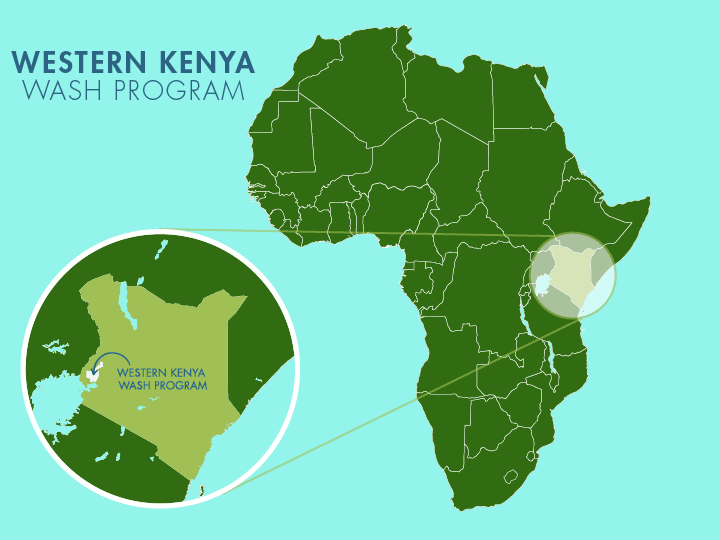For two decades, the 150 residents of Mukhonje Community, a small but vibrant settlement surrounded by sugarcane plantations, have struggled without a safe and reliable water source. Their only option has been a partially protected spring, which serves not just the community, but also a nearby school, a neighboring village, and a local place of worship.

A long line at the unprotected spring.
Every morning and evening, community members trek along the uneven terrain to reach the spring. It is clean in appearance and odorless, but deceptive in its purity. The chemicals used on the sugarcane farms uphill seep into the groundwater, and with every rainfall, runoff washes harmful residues into the spring. Over the years, the consequences have been dire: recurring diarrheal diseases, skin rashes, and strained livelihoods.
Although the community has worked hard to protect the spring, planting vegetation around it to reduce chemical seepage, their efforts have not been sufficient. Only about a quarter of the residents can fetch water within a 30-minute round trip, and overcrowding at the spring means long waits under the hot sun.
Among those affected is David Nyundo, a 44-year-old farmer whose life and livelihood revolve around the rhythms of water and soil. For him, the connection between unsafe water and suffering is deeply personal.

David Nyundo.
“In the first quarter of this year, one of my daughters suffered severe diarrhea. At that time, access to any means of transportation was also a challenge. So, I was forced to carry her near-lifeless body on my back to the hospital and to put up with the continuous diarrhea en route to the hospital. Though we both got to the hospital exhausted, and my daughter severely dehydrated and confused, she was speedily assisted as I rushed back home to collect the few coins I had on me," recalled David.
David’s story is one of love, desperation, and resilience. What should have been a simple case of hydration became a financial and emotional ordeal.
“She had to be on fluids and injectable medications as a resuscitatory measure. Then, some laboratory tests were done to ascertain the exact cause of the diarrhea. This treatment drained my family dry, and my other children almost went without a meal, but my brother came to my rescue," David shared.
The experience left him painfully aware of the cost of unsafe water—not only in terms of money, but also in terms of dignity and hope.
“I am mostly concerned because any ailments connected to the water eat into my pocket, and I loathe unplanned expenditure. Water-related illnesses mainly affect my finances, especially on treatment,” he explained. “It's mind-boggling just even the thought of it. This compelled me and others to approach the land owners uphill and talk to them about other farming alternatives."

Hauling water up the steep hill.
"Before it was partially protected, we took an hour scooping water from the spring. And, being that there are many water users, the water would get dirty, so one had to wait till the water settled before scooping again,” David said.
Now, even with partial protection, he and his children still spend at least 15 minutes waiting at the source—twice a day, morning and evening. “Morning and evening hours because I spend most of my time in the shamba (farm) and my children have to go to school,” he explained.
Like many in Mukhonje, David dreams of what life could be if water were no longer a burden.
“I would tend to my cattle well and ensure they get quality and quantity feeds to improve the milk production. This cushions the family finances and nutrition," David said.

For David and his neighbors, the promise of a protected spring offers new hope. With proper protection, grass planting, and drainage, the community can finally break the cycle of contamination that has plagued them for 20 years.
His final words echo the belief that drives communities like Mukhonje to keep pushing for change: “It is indeed very important to me, because all domestic chores rely on water to get done in the most appealing way.”

The pain and perseverance of the people of Mukhonje reveal what water truly means; it is not just for drinking or washing, but for dignity, health, and the chance to dream without fear. When the new spring is completed, David’s children will no longer have to miss school, and his family will no longer have to choose between treatment and meals.
Water is life—and in Mukhonje, life is waiting to flow freely again.
Steps Toward a Solution
Our technical experts worked with the local community to identify the most effective solution to their water crisis. They decided to safeguard the existing flowing spring.
Spring Protection
Springs are natural water sources that originate from deep underground. As water travels through various layers of the earth, it undergoes a natural filtration process, making it cleaner and safer to drink. To protect these spring sources from contamination, we construct a waterproof cement structure around layers of clay, stone, and soil. This design channels the spring water through a discharge pipe, facilitating easier, faster, and cleaner water collection.
Chlorine Dispenser
As an extra measure towards water quality safety, uniquely engineered chlorine dispensers are installed at all of our spring protection projects so community members can treat their water with pre-measured doses of chlorine. The chlorine treats any possible contamination and stays active for two to three days, ensuring water stays safe to use even when stored at home. Chlorine delivery and maintenance of the dispensers are part of our ongoing community support.
Community Education & Ownership
Hygiene and sanitation training are integral to our water projects. Training is tailored to each community's specific needs and includes key topics such as proper water handling, improved hygiene practices, disease transmission prevention, and care of the new water point. Safe water and improved hygiene habits foster a healthier future for everyone in the community. Encouraged and supported by the guidance of our team, a water user committee representative of the community's diverse members assumes responsibility for maintaining the water point, often gathering fees to ensure its upkeep.

 Protected Spring
Protected Spring
 Rehabilitation Project
Rehabilitation Project
















